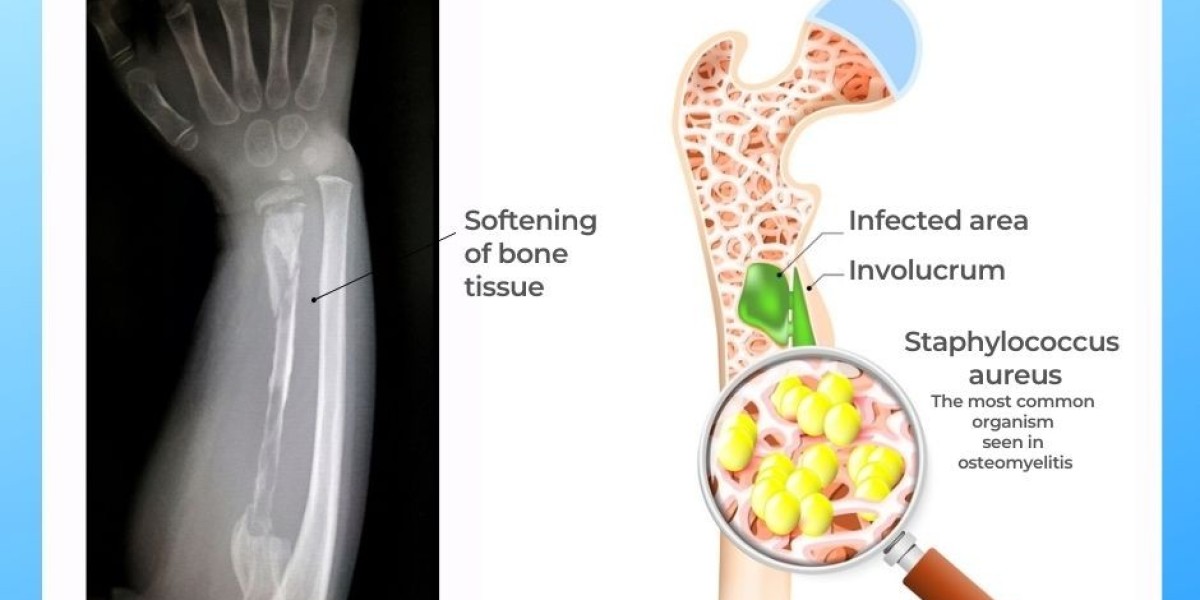Osteomyelitis treatment is a severe bone infection that, if left untreated, can result in significant complications such as bone damage, systemic infection, and even amputations. Timely and appropriate treatment is essential for successful recovery. Below is a detailed overview of the treatment options available for osteomyelitis.
What is Osteomyelitis?
Osteomyelitis refers to an infection of the bone, typically caused by bacteria, though fungi can also be responsible. The infection can occur after trauma, surgery, or from the spread of an infection in nearby tissues. It most commonly affects the long bones, such as the legs and arms, but it can also affect the spine, pelvis, and other areas.
Causes of Osteomyelitis
- Bacterial Infections: Staphylococcus aureus is the most common cause of osteomyelitis. Other bacteria like Streptococcus and Pseudomonas can also cause infections.
- Fungal Infections: In immunocompromised individuals, fungal infections (e.g., Candida or Aspergillus) can infect bones.
- Spread from Nearby Infections: Infections from nearby tissues, such as joints, skin, or soft tissues, can spread to the bone.
- Post-Surgical or Trauma-Related: Surgery or fractures can introduce bacteria into the bone, leading to osteomyelitis.
Symptoms of Osteomyelitis
- Pain and Swelling: The affected bone becomes painful, swollen, and tender to the touch.
- Fever and Chills: A high fever may be present, along with chills and night sweats.
- Redness and Warmth: The skin over the infected area may be red and warm.
- Limited Movement: If the infection involves joints or near the spine, it can restrict movement or cause difficulty in mobility.
Treatment Options for Osteomyelitis
1. Antibiotic Therapy
The cornerstone of treatment for osteomyelitis is antibiotic therapy. Antibiotics are used to eliminate the infection and prevent it from spreading.
- Intravenous (IV) Antibiotics: Initially, high-dose antibiotics are administered intravenously in a hospital setting for the first few weeks. This is typically done when the infection is severe or widespread.
- Oral Antibiotics: After the initial phase of IV antibiotics, oral antibiotics are prescribed for several weeks to ensure the infection is fully treated. The duration of treatment can vary depending on the severity of the infection, ranging from 6 to 12 weeks or more.
- Targeted Antibiotics: Antibiotics are selected based on the specific bacteria or fungi causing the infection, determined through blood cultures or biopsy results.
2. Surgery
Surgical intervention is often required for severe or chronic osteomyelitis, or when antibiotics alone do not resolve the infection.
- Debridement: The removal of necrotic or infected tissue is essential to stop the infection from spreading. The surgeon will clean out infected bone and tissue during this procedure.
- Abscess Drainage: If an abscess or pus is present in the infected area, draining it is necessary to remove the infection.
- Bone Grafting: In cases where the bone has been significantly damaged, a bone graft or artificial bone may be implanted to replace the infected bone and promote healing.
- Amputation: In extreme cases where the infection cannot be controlled or has led to severe tissue loss, amputation may be required to save the patient's life.
3. Hyperbaric Oxygen Therapy (HBOT)
HBOT is an adjunctive treatment option for chronic or resistant osteomyelitis. It involves placing the patient in a pressurized chamber where they breathe pure oxygen. This enhances oxygen delivery to infected tissues, improves healing, reduces swelling, and aids in fighting infection.
4. Pain Management
Managing pain effectively is important to allow patients to recover more comfortably.
- Pain Relievers: Over-the-counter nonsteroidal anti-inflammatory drugs (NSAIDs) such as ibuprofen or acetaminophen can be used for pain relief and to reduce inflammation.
- Stronger Medications: In severe cases, stronger prescription painkillers such as opioids may be prescribed for short-term pain control.
- Physical Therapy: For patients who undergo surgery or experience limited mobility due to the infection, physical therapy can help restore movement and strength in the affected limb.
Monitoring and Follow-Up Care
After the initial treatment phase, patients will need to follow up with their healthcare provider to ensure that the infection is resolving and that healing is progressing. This typically involves:
- Imaging: X-rays, MRI, or CT scans may be performed to monitor bone healing and check for any signs of remaining infection.
- Blood Tests: Regular tests to check for signs of infection or inflammation.
- Continued Antibiotic Therapy: In some cases, patients may need long-term oral or IV antibiotics, especially for chronic osteomyelitis.
- Rehabilitation: Patients who have undergone surgery or are recovering from severe osteomyelitis may need physical therapy to regain strength and mobility.
Prevention of Osteomyelitis
Preventing osteomyelitis involves addressing the factors that increase the risk of bone infections:
- Timely Treatment of Infections: Early treatment of bone, joint, or soft tissue infections can prevent the spread of infection to the bone.
- Wound Care: Proper cleaning and care of wounds, particularly surgical wounds or fractures, can reduce the risk of infection.
- Management of Chronic Conditions: Conditions like diabetes, vascular diseases, or immune system disorders should be managed effectively to reduce susceptibility to infections.
Prognosis
The prognosis for osteomyelitis depends on various factors, including the severity of the infection, the patient’s overall health, and the timeliness of treatment. With appropriate antibiotic therapy and surgical intervention, most people recover fully. However, if left untreated or in chronic cases, osteomyelitis can lead to severe complications such as bone destruction, sepsis, and the need for amputation.
Conclusion
Osteomyelitis is a serious bone infection that requires immediate attention and comprehensive treatment, including antibiotics, possible surgery, and follow-up care. With the right approach, most patients recover successfully, preventing long-term complications. Early detection and timely intervention remain key to managing the infection effectively.









